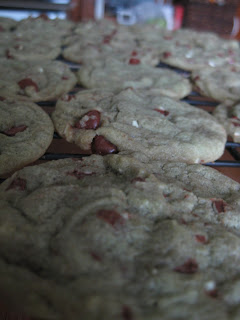I could wax poetic about the joys of breakfast for days. What other meal so deftly combines the sweet, the salty and the ooey gooey? With a plate of pancakes, scrambled eggs, hash browns and not-sausage covered in maple syrup, I am quite the happy gal.
Yet a steady diet of aforementioned fare will surely increase the waistline as well as the chances of contracting Type II die-ah-beed-us, so we can't live like obese monarchs every single morning.
Enter the humble, yet tasty, muffin. The heartier sibling in the mini-cake tribe, you can throw just about anything into a muffin: fruit, grains, cheese, vegetables. As a kid, I relied heavily upon the Martha White muffin mixes in a bag. Add in some water or milk, maybe some oil, and you were ready to fill in some muffin tins. The mixes were completed with pellet formed "fruit", small cylinders of blue or red color chock full of corn starch, dye and artificial flavors. Yum!
Alex's friend came to visit us a few weekends ago, and I thought that I would make something special for breakfast. Here's my recipe for my first-ever try at REAL blueberry muffins:
2 cups all purpose flour or cake flour
1/2 teaspoon salt
1/2 cup (1 stick) unsalted butter, softened
1 cup sugar
2 large eggs
2 teaspoons vanilla extract
1/2 cup whole milk
2 cups blueberries, fresh or frozen
Streusel Topping:
1/3 cup sugar 1/4 cup flour
1/4 cup oats
2 tbsp butter, softened
1 tsp cinnamon
Oven at 350- grease or paper your muffin tins!
Sift the flour, baking powder and salt together. Cream the butter and sugar. Add the eggs, vanilla and milk into the creamed sugar. Once it is combined, add it to the dry ingredients in three or four installments- don't just throw it all in at once.
Fold the blueberries into the mix. Spoon the finished batter into your muffin tins. This recipe should yield 12-16 muffins, depending on where your fill line may be in your tins.
For the streusel, melt the butter and add in all the ingredients. You can mix it with a fork or with your fingers. Sprinkle the streusel directly on top of the batter in the muffin tins.
Bake these babies between 20 and 25 minutes, then let them cool thoroughly. Hot blueberries can be like lava bombs, which isn't so great.
Perhaps you're wondering what's up with the flour choices? Well, cake flour is incredibly fine and makes a very soft, almost silky cake. All purpose flour isn't as refined, so the end result isn't as smooth, but it is just as tasty. You don't need to change baking times for either flour, nor do you need to whip out the fine china if you use the baking flour.
You may, however, want to ration these muffins. They are crazy good!

























